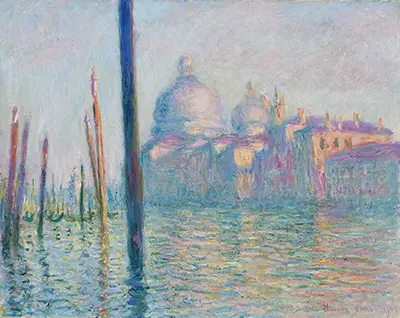Completed in 1908, this oil-on-canvas painting is thought by many to represent the pinnacle of his career. It was actually one in a series of works produced during the same year.
Known for its use of light and airy colours, Le Grand Canal is certainly one of the most celebrated paintings produced by this artist.
The History Behind Le Grand Canal
Monet was already a well-seasoned artist by the time that he undertook this project. He had just turned 68 years old and he had already been a notable member of the Impressionist movement since the 1860s. One contrast worth noting when compared to his previous pieces is that Le Grand Canal contains much more muted (although still iridescent) tones.
Some believe that this was a direct result of his emotional shift after his wife died of tuberculosis in 1879 at the young age of 32. Regardless of whether or not this interpretation is founded upon fact, there is indeed an uncanny similarity between the tones used in Le Grand Canal and those adopted for Camille Monet on Her Deathbed (1879).
Monet was originally invited to Venice at the behest of an American woman by the name of Mary Young Hunter. Hunter was a friend of his second wife Alice. She asked the couple to stay at the Palazzo Barbaro (which she was renting at the time). While Monet was hesitant at first, he eventually relented and the couple arrived on 1 October 1908.
Capturing Moments in Time
One of the pervasive throughout Monet's later years was an attempt to capture the essence of an image through the use of light. The style of Le Grand Canal is en plein air and the entire series of the 37 paintings adopts this same perspective. What is most notable about this work in particular is the means by which Monet translated its form to canvas.
As opposed to completing it in a handful of sittings, he instead chose to paint this Venice scene at different times throughout the day in order to understand how the ambient light interacted with the surroundings. This is perhaps the reason why it painting utilises both light and dark hues within close proximity.
It is therefore no surprise that the foreground heavily emphasises the presence of water; as if to indicate that nothing is static within nature. The use of mooring poles likewise serves as a counterbalance between the light colours in the background. This helps to provide a sense of visual depth. Thus, structures in the distance such as the Church of Santa Maria della Salute take on a rather muted appearance.
The Ultimate Intention of Le Grand Canal
It is agreed that Monet was attempting to illustrate the relationship between solid objects and ethereal light. Indeed, this same technique can be seen in similar series such as Water Lilies and Charing Cross Bridge. We are nonetheless left to wonder if the attempt to immortalise light and life upon canvas has a great deal to do with the untimely death of his first wife at a young age. See also Grand Canal, Venice by Turner.


